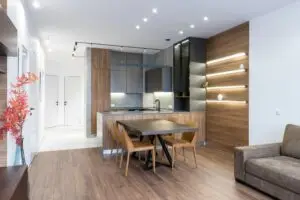 As we move into 2025, the world of interior design continues to evolve, with lighting playing a pivotal role in shaping spaces. Lighting design trends are becoming increasingly important, not just for aesthetic appeal but also for enhancing functionality and promoting sustainability. In this article, we’ll explore the top color trends in lighting, the implications of smart lighting, and the rise of eco-friendly materials in lighting design.
As we move into 2025, the world of interior design continues to evolve, with lighting playing a pivotal role in shaping spaces. Lighting design trends are becoming increasingly important, not just for aesthetic appeal but also for enhancing functionality and promoting sustainability. In this article, we’ll explore the top color trends in lighting, the implications of smart lighting, and the rise of eco-friendly materials in lighting design.
Top Color Trends in Lighting
Color is a powerful tool in lighting design, influencing mood, perception, and style within a space. In 2025, expect to see a surge in bold and unconventional color palettes.
1. Warm Tones
Warm colors, such as rich ambers, deep oranges, and soft yellows, are set to dominate lighting design. These hues can create a cozy atmosphere, perfect for residential spaces where comfort is key.
2. Jewel Tones
Emerald greens, sapphire blues, and ruby reds are making a comeback, lending a sense of luxury and elegance to interiors. These saturated colors can be used in statement lighting fixtures to add depth and drama to a room.
On the softer side, pastel colors like mint green, lavender, and peach are increasingly popular. They offer a serene and calming effect, ideal for spaces such as bedrooms and living areas where relaxation is paramount.
4. Dynamic Color Changing
With technology advancing, dynamic color-changing LED lights are gaining traction. They allow users to switch between colors and adapt to various moods and activities, which is appealing for both residential and commercial spaces.
Smart Lighting and Its Implications
The integration of smart technology in lighting is transforming how we interact with our spaces. In 2025, smart lighting solutions are expected to become even more sophisticated and user-friendly.
1. Automation and Customization
Smart lighting systems offer users greater control over their environment. Features such as scheduling, remote access, and voice activation allow individuals to create customized lighting scenarios that fit their lifestyle, enhancing convenience and comfort.
2. Energy Efficiency
Smart lighting also promotes energy efficiency. By utilizing sensors and automated systems, users can reduce energy consumption, only using light when and where it’s needed. This not only lowers utility bills but also contributes to a smaller carbon footprint.
3. Integration with Smart Home Systems
As smart homes become more prevalent, lighting systems will seamlessly integrate with other smart devices. This interconnectedness allows for comprehensive home management, optimizing comfort, security, and energy use.
Eco-Friendly Materials in Lighting Design
![]()
![]() Sustainability is a driving force in design, and lighting is no exception. In 2025, eco-friendly materials will play a significant role in lighting design.
Sustainability is a driving force in design, and lighting is no exception. In 2025, eco-friendly materials will play a significant role in lighting design.
1. Recycled Materials
Designers are increasingly using recycled materials in lighting fixtures. Whether it’s reclaimed wood, repurposed metals, or recycled glass, these materials not only reduce waste but also offer unique aesthetic qualities.
2. Biodegradable Options
Innovative designs using biodegradable materials are emerging in the lighting industry. Fixtures made from organic materials can provide sustainable solutions that are not only functional but also environmentally friendly.
3. Energy-Efficient Technologies
The shift toward energy-efficient lighting, such as LED technology, will continue to grow. These innovations lower energy consumption and have longer lifespans, reducing waste and environmental impact.
As we look ahead to 2025, the trends in lighting design reflect a shift towards bold colors, smart innovations, and sustainability. Whether you’re redesigning a space or simply looking to update your lighting fixtures, embracing these trends will not only enhance the aesthetic appeal of your home but also support a more sustainable future. Keep an eye on these trends as they shape the interiors of tomorrow, making lighting not just functional, but a statement of style and responsibility.

